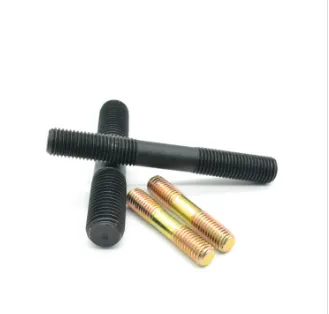Hex Bolts: Standardization, Universality, and Industrial Cornerstones
ئىيۇن . 10, 2025 09:20 تىزىملىككە قايتىش
Hex Bolts: Standardization, Universality, and Industrial Cornerstones
Hex Bolts, As a fundamental and widely used fastener, it plays a crucial role in modern industrial systems. With its unique hexagonal head design, standardized production standards, and excellent mechanical performance, it has become an indispensable component for connecting, fixing, and supporting various structures and mechanical equipment. This article will explore the value and significance of Hex Bolts from three aspects: standardization, universality, and importance in industrial applications.

The standardization of Hex Bolts is the foundation for its large-scale application
The International Organization for Standardization (ISO), German Industrial Standards (DIN), and American National Standards Institute (ANSI) have all developed detailed specifications for bolts, covering dimensions, materials, strength grades, surface treatments, and other aspects. This standardization ensures the interchangeability of Hex Bolts produced by different manufacturers, making it convenient for users to choose and replace, and reducing maintenance costs. In addition, standardization has promoted the improvement of production efficiency, achieved large-scale automated production, reduced manufacturing costs, and made Hex Bolts an economical and practical fastening solution.
The universality of Hex Bolts is reflected in its wide range of application fields
Carbon steel hex bolts can be found in almost all industrial fields, from large bridges and building structures to precision electronic instruments and automotive components. This is due to its simple structure, easy to operate characteristics, and diverse specification choices. Hex bolts of different lengths, diameters, and materials can meet the needs of different application scenarios. For example, high-strength Hex Bolts are commonly used in applications that can withstand high stress, such as bridges and large machinery; Stainless steel Hex Bolts are suitable for environments that require corrosion resistance, such as chemical equipment and food processing equipment. This strong versatility makes Hex Bolts the preferred fastener for engineering design.
Hex Bolts play a foundational role in industrial applications
Whether assembling simple furniture or building complex aircraft, double end stud bolts play an important role in connecting and securing them. It not only provides reliable connection strength, ensuring structural stability and safety, but also facilitates disassembly and maintenance. On automated production lines, robotic arms can quickly and accurately tighten Hex Bolts, improving production efficiency. During the repair process, technicians can easily use a wrench to loosen or tighten Hex Bolts for component replacement and adjustment. It can be said that Hex Bolts are an indispensable cornerstone supporting the operation of modern industrial systems.
In summary, Hex Boltsgrade4.8 hex bolts have become an indispensable component of modern industrial systems due to their standardized production specifications, wide versatility, and importance in industrial applications. It not only simplifies engineering design, reduces maintenance costs, but also improves production efficiency, providing strong support for the development of various industries. With the continuous advancement of industrial technology, Hex Bolts will continue to develop and improve, playing a more important role in future industrial applications.
Hex Bolts FAQs
How is the head height standard for Hex Bolts defined?
The standard hexagonal head height is generally 0.8 times the bolt diameter (such as M10 bolt head height of about 8mm)
Thin hexagonal head with a height of 0.5 x diameter
Thick hexagonal head with a height of up to 1.0 x diameter
Specific dimensions refer to standards such as ISO 4014 (standard type), ISO 4017 (thick type), etc
How to calculate the opening size of Hex Bolts wrench?
Standard hexagonal head width (wrench size)=1.5 x bolt diameter+3mm
For example, the width of the opposite side of the M8 bolt is 13mm (using a 13mm wrench)
British bolts: such as 1/2 "bolts corresponding to 3/4" wrenches
Specially designed bolts may have different wrench opening requirements
How to determine the preload force of high-strength Hex Bolts?
Calculation formula: Pre tightening force=0.7 × bolt yield strength × effective cross-sectional area
Typical pre tightening force of 8.8 grade M20 bolt is about 160kN
Level 10.9 M20 can reach 220kN
Adjustments should be made considering the material of the connecting components and the operating conditions (vibration, temperature, etc.)
What are the specifications for the thread engagement length of Hex Bolts?
Generally, it is required that the screwing length be ≥ 1 times the bolt diameter
High strength connection requirement 1.52 x diameter
Soft materials such as aluminum alloy require a diameter of 2.5 x
Refer to VDI 2230 standard for detailed calculations
How to detect the axial stress of Hex Bolts?
Torque method: T=K × d × F (K is the torque coefficient, d is the diameter, F is the preload force)
Angle method: Rotate a specific angle to control the preload force
Ultrasonic measurement: calculating stress through sound time variation
Strain gauge measurement: directly measure bolt strain
Hydraulic tensioner: precise control of bolt elongation
ئەڭ يېڭى خەۋەر
-
Bolts for Lawn Mower Handle Supplier | OEM & Rust-Resistant
خەۋەرلەرNov.17,2025
-
Silver Screws Supplier | Corrosion-Resistant, Bulk & Custom
خەۋەرلەرNov.17,2025
-
Cabinet Bolts Supplier | OEM, Bulk Stock, Fast Shipping
خەۋەرلەرNov.17,2025
-
Axle Nuts Supplier - OEM-Grade, ISO-Certified, Fast Delivery
خەۋەرلەرNov.17,2025
-
Wire Bolts Suppliers – OEM Factory Prices, ISO Quality
خەۋەرلەرNov.11,2025
-
Bolts for Lawn Mower Handle Supplier – OEM & Anti‑Rust
خەۋەرلەرNov.11,2025
